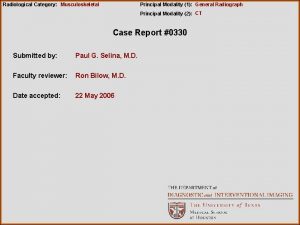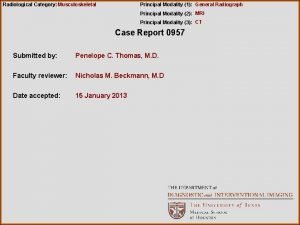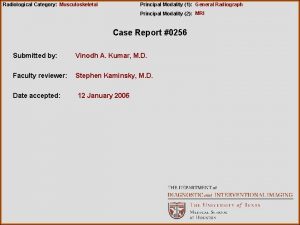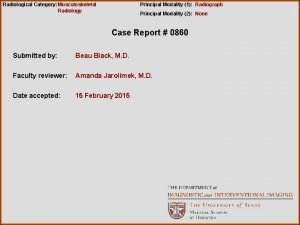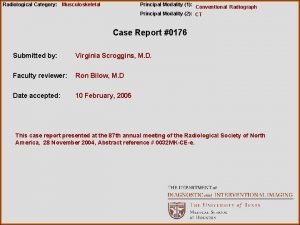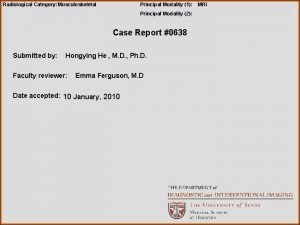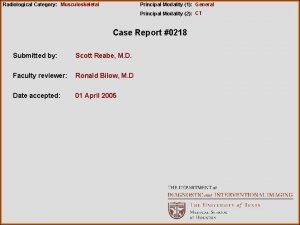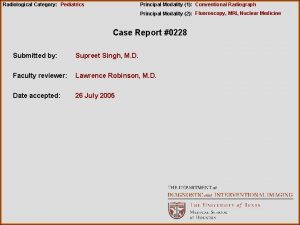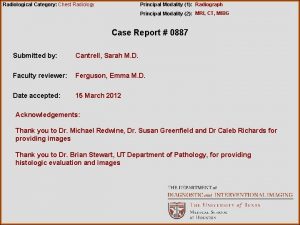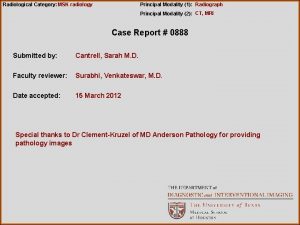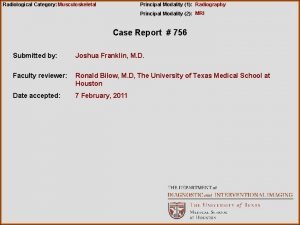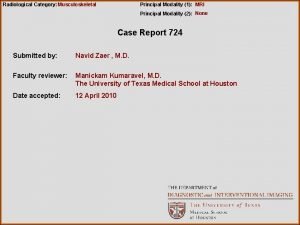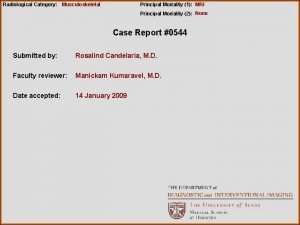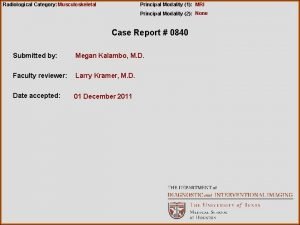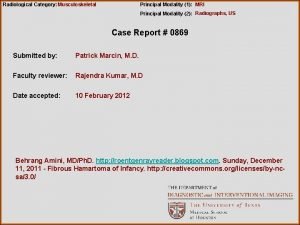Radiological Category Musculoskeletal Principal Modality 1 General Radiograph




















- Slides: 20

Radiological Category: Musculoskeletal Principal Modality (1): General Radiograph Principal Modality (2): MRI Principal Modality (3): CT Case Report 0957 Submitted by: Penelope C. Thomas, M. D. Faculty reviewer: Nicholas M. Beckmann, M. D Date accepted: 15 January 2013

Case History 45 year-old man with right knee pain.

Radiological Presentations AP and Lateral Radiographs

Radiological Presentations Coronal T 1

Radiological Presentations

Radiological Presentations

Radiological Presentations Coronal PD Fat Saturated

Radiological Presentations

Radiological Presentations

Test Your Diagnosis Which one of the following is your choice for the appropriate diagnosis? After your selection, go to next page. • Mastocytosis • Osteopoikilosis • Sclerotic Metastases

Findings and Differentials Findings: Right knee radiographs: No fractures or periosteal reaction. Multiple, benignappearing sclerotic foci of varying sizes within the distal femur and proximal tibia in a periarticular distribution. Right knee MRI: No fractures or edema. Multiple small T 1 and T 2 hypointense foci in the periarticular bone marrow. Differentials: • Mastocytosis • Osteopoikilosis • Sclerotic Metastases

Discussion Mastocytosis: Clonal disorder of mast cells and its precursors. Characterized by proliferation and accumulation of mast cells within various organs, most commonly in the skin. Usually presents in adulthood with flushing, abdominal pain, diarrhea, syncope, and urticaria pigmentosa. Patients can also complain of bone pain. Diagnosis is made via bone marrow biopsy. Patients commonly have osseous abnormalities. Lesions can be focal or diffuse and can progress. Radiographic findings are that of osteosclerosis or osteoporosis. Low intensity lesions on T 1 -weighted MRI. Lesions are hyperintense on T 2 weighted imaging. This case does not represent mastocytosis because the lesions are not T 2 hyperintense. The patient also does not have the clinical symptoms associated with mastocytosis.

Discussion Osteopoikilosis: Also known as Osteopathia Condensans Disseminata or Albers Schonberg Disease. “Bone polka dots”. Rare autosomal dominant or sporadic disease characterized by multiple, small, widely distributed sclerotic foci within the bones. These represent bone islands or foci of compact bone in cancellous bone. Usually an incidental finding on radiographs obtained for another clinical concern. Lesions are found clustered around joints in the epiphyses and metaphyses of appendicular bone. Rib, clavicle, spine, and skull involvement is rare. Diagnostic on plain radiographs – well-defined, sclerotic lesions in a periarticular distribution. Low signal intensity lesions on T 1 and T 2 -weighted MRI. Bone scan is normal.

Radiological Presentations Osteopoikilosis: Right knee AP radiograph demonstrates multiple well-defined sclerotic lesions (yellow arrow) in a periarticular distribution. There is no fracture or periosteal reaction.

Radiological Presentations Osteopoikilosis: Right knee MRI demonstrates multiple, small, well-defined hypointense lesions surrounding the knee joint on both T 1 (far left) and proton density/ fluid sensitive (near left) weighted imaging. A representative lesion has been selected (yellow arrow).

Discussion Sclerotic Metastases: Usually due to metastatic breast or prostate cancer, less likely due to lung, Hodgkins disease, lymphoma, or carcinoid. Represents hematogenous spread. The appearance is variable and may be well-defined but often can be irregular without distinct zone of transition. Lesions tend to occur in a distribution pattern similar to red marrow, predominantly occurring in the axial and proximal appendicular skeleton. Patients can be asymptomatic or present with bone pain or fractures. Lytic metastases become sclerotic after treatment. While the appearance of metastases is variable, it is not the answer for this case. The lesions are very well-marginated and have a symmetric distribution.

Diagnosis Osteopoikilosis or Osteopathia Condensans Disseminata This was an incidental finding. On MRI, a lateral meniscal tear was seen which was the likely cause of this patient’s knee pain. Review of prior imaging also demonstrates similar lesions involving the left knee and pelvis.

Radiological Presentations Osteopoikilosis: Left knee AP radiograph of the same patient also demonstrates multiple well-defined sclerotic lesions in a periarticular distribution.

Radiological Presentations Osteopoikilosis: CT of the abdomen and pelvis performed in the same patient demonstrates multiple sclerotic lesions adjacent to bilateral hip joints.

References Greenspan A. Sclerosing Bone Dysplasias – A Target-Site Approach. Skeletal Radiol. 1991; 20 (8): 561 -83. Horwitz M. Osteopathia Condensans Disseminata. Radiology. 1943; 40: 404 -407. www. Learning. Radiology. com www. Statdx. com
 Pa erate
Pa erate National radiological emergency preparedness conference
National radiological emergency preparedness conference Radiological dispersal device
Radiological dispersal device Tennessee division of radiological health
Tennessee division of radiological health Center for devices and radiological health
Center for devices and radiological health Characteristics of sensory neurons
Characteristics of sensory neurons Sodality vs modality
Sodality vs modality Modality
Modality Cardinality and modality
Cardinality and modality Cardinality and modality
Cardinality and modality Cardinality and modality
Cardinality and modality Modality microsoft services
Modality microsoft services Epistemic modality
Epistemic modality Birads grade
Birads grade What is modality in statistics
What is modality in statistics Modality
Modality Modality in software engineering
Modality in software engineering Entity class in software engineering
Entity class in software engineering Epistemic modality
Epistemic modality Modality in software engineering
Modality in software engineering Cardinality and modality in database
Cardinality and modality in database





















